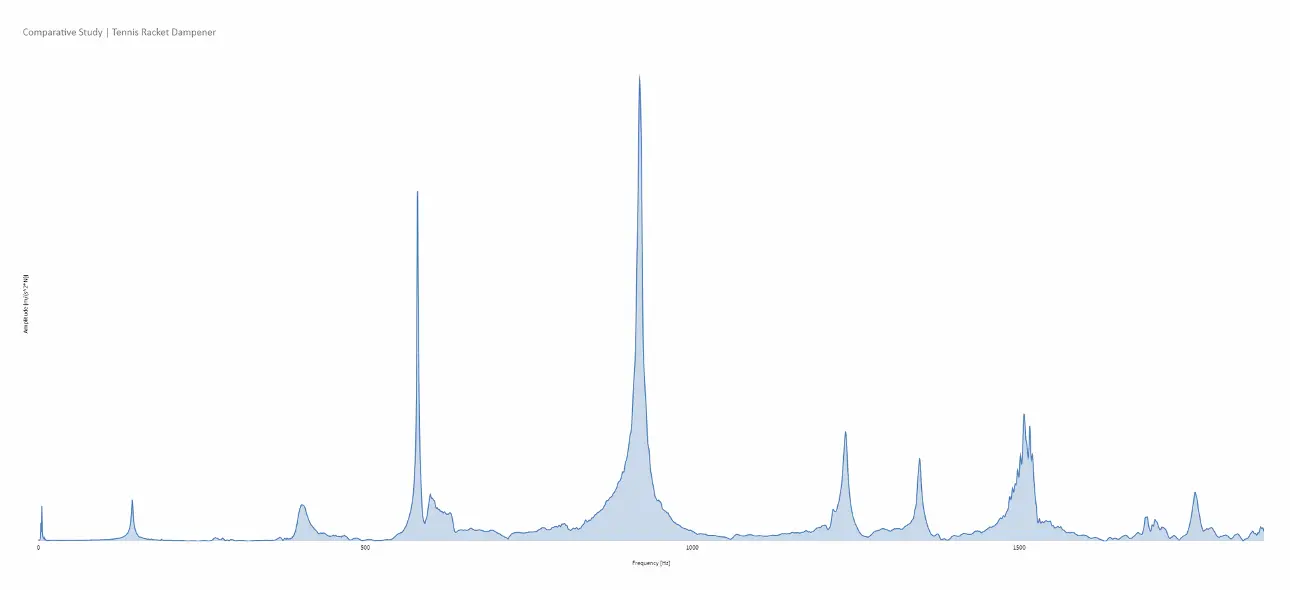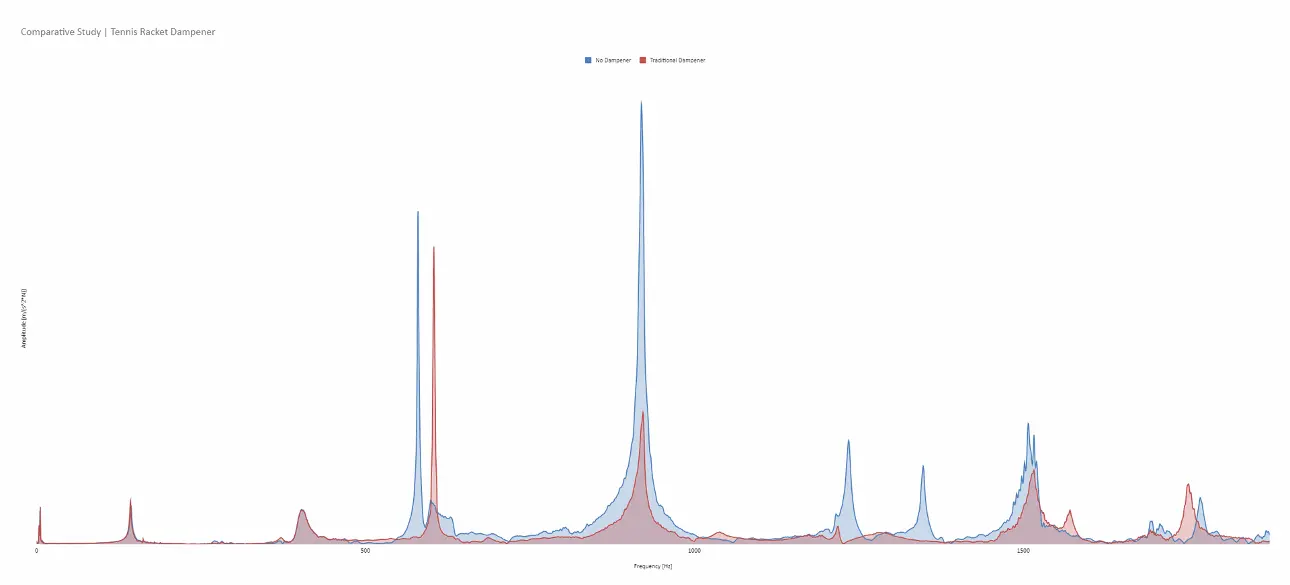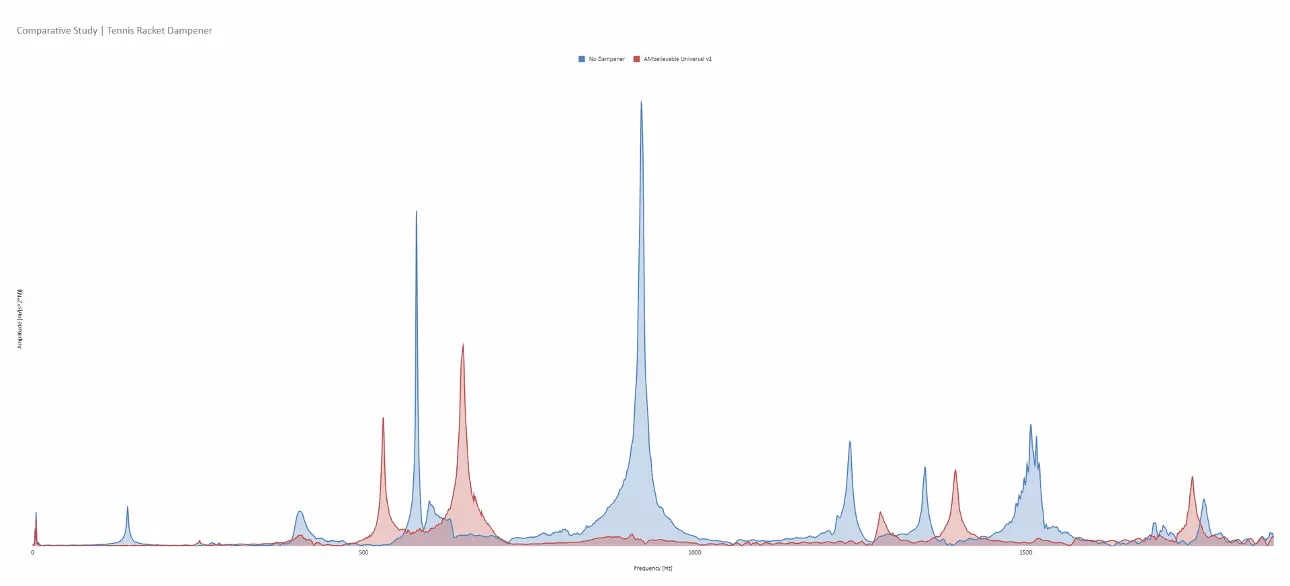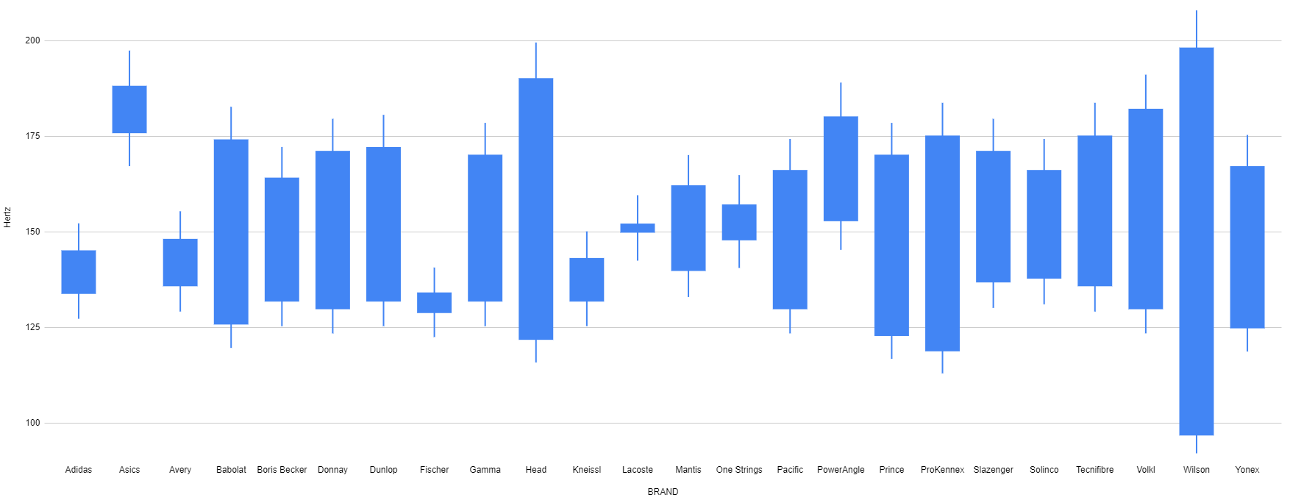How a Tennis Racket Vibrates
Is The Tennis Dampener Effective In Reducing Vibrations? Uncover the science behind this often overlooked device and learn why AMbelievable™ is by far the best-in-class product.
The State of Tennis Dampener Technology Before AMbelievable™
More than a decade ago (in 2008), a group of researchers, led by the former R&D Director of the renowned sports equipment producer Head NV (Mr. Mohr), conducted one of the first extensive scientific studies focused on the vibration modes of a Tennis racket. The analysis, supported by advanced lab equipment, investigated the vibration characteristics of a tennis racket —to be more specific: a "tennis racket system", including the racket's frame, the string-bed and a traditional damper.
The conclusions indicate three main findings:
- Traditional string dampers must have a minimum mass to be effective. Below 2 grams, they do not produce any significant effect in any position.
- Traditional string dampers must be tuned to provide optimized damping conditions for individual tennis racket configurations.
- Traditional string dampers do not affect the rackets' frame bending modes at lower frequencies; instead, they have real effects on the higher-frequency response, going beyond being an aesthetically pleasing addition to the racket.
Those findings became the foundation for string dampener production. While material advancements have introduced aesthetic improvements and slight performance gains, no significant innovation emerged until AMbelievable™ entered the scene. To demonstrate the impact of our breakthrough, we commissioned an independent study to compare the 2008 data with new measurements. Using enhanced acquisition technology and a more refined experimental setup, this follow-up study also evaluated the performance of our AMbelievable product line, confirming its superior results.
The typical vibration spectra of a tennis racket
When a tennis racket vibrates after hitting a ball, it shakes or moves in different ways, depending on where and how the ball hits the racket. These different movements are called "modes" of vibration. A mode is just a specific way the racket shakes, and each mode happens at a certain frequency (how fast the vibration is happening).
Here’s a breakdown of three main types of vibration modes:
- Frame Bending Mode: Imagine the racket’s frame, the part you hold, bending slightly back and forth, kind of like a diving board bending when someone jumps on it. This happens at a relatively low frequency. It’s a slow and noticeable vibration because the whole frame is involved, and the mechanical forces are transferred to your harm.
- Torsion Mode: In this mode, the racket twists around its center axis. Think of it like wringing a towel: one end rotates in one direction, and the other end rotates in the opposite direction. This twisting motion usually happens at a higher frequency than bending.
- String Bed Mode: This mode involves the strings vibrating after the ball hits them, like the strings of a guitar after being plucked. These vibrations are the fastest (high frequency) because the strings are much lighter and more flexible than the frame.
Each mode happens at a different frequency because of how much mass (weight) is involved and how stiff or flexible the racket is in different areas. In a vibration spectrum chart, like the one you see here below, you can see these modes as separate peaks, with frame bending happening at lower frequencies, torsion somewhere in the middle, and string-bed mode at higher frequencies.
Chart A | Frequency spectrum of a tennis racket without tennis dampener
This chart shows the racket's natural vibration behavior without a dampener. The prominent peaks represent different vibration modes: lower frequencies correspond to frame bending, medium frequencies to torsion, and higher frequencies to string vibrations. These peaks indicate that, without dampening, the racket experiences significant vibrations across a wide range of frequencies.
It has been scientifically proven that lower frequencies negatively affect inflammatory issues;. Additionally, in 2019, a group of researchers at Singapore University performed an in-depth study about how vibrations affected tennis players' performances and demonstrated that using a vibration-dampening device increased overall performance by a stunning 25%. More importantly, the study showed clear evidence that a vibration damper could increase the accuracy of the hits during the fatigue phase and delay it.

Fig. 1 Chart A: Frequency spectrum, measured in Hertz, of a tennis racket without dampener (blue line), and with a traditional 3-gram silicon dampener. (Source: Independent Lab Test by HEAD Acoustics GmbH)
Chart B | Frequency spectrum of a tennis racket with a traditional tennis dampener
Here, we compare the racket's natural vibrations to the effect of a traditional dampener. The traditional dampener reduces vibration peaks, especially around the higher frequencies associated with string bed vibrations. However, while the peaks are smaller, the dampener's impact is negligible at lower frequencies (i.e., frame bending and torsion), indicating that traditional dampeners provide amplitude reductions. Still, those are not comprehensive in their effect on all modes.

Fig. 2 Chart B: The above chart shows the frequency spectrum, measured in Hertz, of a tennis racket without dampener (blue line), and with a traditional 3-gram silicon dampener. (Source: Independent Lab Test by HEAD Acoustics GmbH)
It's interesting to note that the effect of a traditional dampener is concentrated on frequencies around 900 Hz and 1200-1300 Hz, where its impact is more significant. The dampener also acts as a mode shifter on other frequences (i.e., around 550 Hz and 1700 Hz), meaning it shifts the frequency of the racket's vibration. These results are consistent with the study by Morh et al. (2008). Still, we achieved a cleaner and broader perspective due to certain setup limitations encountered by the 2008 paper's authors. Specifically, their choice of experimental setup—i.e., hanging the racket with a nylon wire—introduced some measurement limitations, whereas the lab that performed the analysis in 2024 used a cleaner setup.
The AMbelievable™ Tennis Dampener Technology
Since 2008, advancements in 3D printing, metamaterials, and engineering have dramatically reshaped what's possible in sports equipment. Breakthroughs in precision manufacturing, material science, and computer-aided design have allowed us to create technologies that were once only imagined. AMbelievable™ leverages these innovations to bring you a tennis dampener that goes beyond traditional limits, delivering unprecedented vibration control and a customized playing experience.
What Are Metamaterials?
Metamaterials are artificially engineered materials designed to have properties not found in natural substances. Almost any material can be engineered to be a metamaterial because its properties are derived from the geometric arrangement of its meso-structure (meaning their 'larger' structure, called meta-cells) rather than the microstructure (i.e., atoms and molecules) that the material is made of. By arranging internal components in precise geometrical patterns, metamaterials can unconventionally control electromagnetic waves, sound, or mechanical vibrations. Unlike traditional materials, which derive their characteristics from their chemical composition, metamaterials derive their abilities from the way their internal structures interact with incoming waves.
Lattice Structures and Vibration Absorption
Lattice structures are one type of metamaterial that excels at vibration absorption due to their geometrically intricate network of repeated cells. These cells can be designed to maximize energy dissipation by flexing in specific ways when subjected to vibrations. Because of their carefully crafted geometry, lattice structures can break up incoming vibrations, distributing the energy and reducing its impact. This makes them highly efficient at dampening unwanted mechanical energy, which is particularly beneficial in applications like sports equipment, where reducing vibrations can enhance comfort and performance.
Tuning Metamaterials for Specific Frequencies
One of the most compelling advantages of metamaterials is the potential to "tune" them to manipulate certain frequencies. By adjusting the shape, size, or arrangement of their internal structure, metamaterials can be engineered to amplify or reduce specific frequencies. This means that they can be made to scatter, concentrate, or block vibrations depending on their design requirements. This tunability allows the creation of custom solutions for damping or even enhancing vibrations in a precise frequency range, providing a level of control that conventional materials cannot achieve. The impact of this innovation applied to tennis dampener is outstanding, and the data gatehred during the 2024 follow-up study speak by themselves.
Chart C | Frequency spectrum of a tennis racket with an AMbelievable™ dampener
This chart shows the comparison between "no dampener" and the "AMbelievable Universal v1" dampener. The Universal v1 dampener significantly reduces vibration peaks across all frequency ranges, from frame bending to torsion and string bed modes. This demonstrates its effectiveness in minimizing both low- and high-frequency vibrations, offering the player more comfort and stability during play. The smoother vibration response suggests a substantial improvement in overall racket feel.
What's the secret (or rather, the patent)? The AMbelievable Universal v1 dampener leverages metamaterials, an advanced technology that allows precise control over vibration frequencies. Metamaterials can be engineered to either amplify or reduce specific frequencies, enabling fine-tuned manipulation of vibration modes. In this case, the AMbelievable Universal v1 dampener effectively reduces vibration across both low and high frequencies.
More interestingly, as noted in a study by Morh et al., a mass of only 1 gram (such as that of the AMbelievable dampener) was previously thought insufficient to create measurable dampening effects on high freqeancies. Furthermore, the mass of a traditional dampener (>3 grams) was considered insufficient to measurably reduce low-frequency vibrations. Despite this, the metamaterial design enables significant vibration reduction even below the 1 gram threshold, demonstrating that precise design tuning can compensate for the lightweighting. In conclusion, by harnessing the power of metamaterials, AMbelievable’s dampener can significantly outperform conventional models by targeting and mitigating specific frequencies more effectively.
These findings are a genuine breakthrough in the field of vibration reduction.

Fig. 3 Chart C: The above chart shows the frequency spectrum, measured in Hertz, of a tennis racket without dampener (blue line), and with an AMbelievable™ 1-gram 3d printed dampener. (Source: Independent Lab Test by HEAD Acoustics GmbH)
If you'd love diving into the technical details, head to the end of the page and subscribe to receive the full scientific paper on the topic. In the document we'll delve into the modal analysis (i.e. how the racket actually moves and vibrates with and without our dampener, and what the frequency spectrum tells us about a power-shot or a more "controllable" racket), and we will also explain how the metamaterials technology allows us to finely manipulate vibration frequencies —paving the way for the very first personalized tennis dampener ever produced worldwide.
The need for customization
As we introduced earlier, customization in tennis string dampeners is crucial because each racket and string setup produces unique vibration profiles. The effectiveness of a dampener depends on specific factors like racket frame, string type, tension, and player style. A 'one-size-fits-all' approach falls short, highlighting the need for tailored solutions to optimize vibration control and performance. Customized dampeners can target specific frequencies, enhancing comfort, control, and reducing injury risks.
To better support the concept, we publish for the first time a set of data regarding several tennis rackets' natural vibration frequency.
Chart E | Frame-Related Frequency Vibration Intervals of Tennis Rackets by Brand
Curious about how your own tennis racket vibrates? The chart below shows the natural frame vibration frequencies for each brand, with each racket having a unique frequency. Some brands cover a wide range of frequencies due to the variety of models they offer, while others focus on a narrower range.
Our database includes over a thousand racket models, each tested for its natural frequency, stiffness, and weight. This data helps us create customized dampeners for each specific model. We're also analyzing various string types, tension levels, and swing effects, such as spin, force, and impact angle. It's a significant project, and we aim to complete it in the coming months.
Fig. 4 Chart E: Natural Frame Vibration Frequency (bending mode only) for All Racket Models, Grouped by Brand (Source: Multiple Sources)
Conclusion
According to this comparative study, the AMbelievable Universal v1 ranks as the most effective dampener, followed by the AMbelievable Tuned Balance v1. Traditional Dampeners, while providing some vibration relief, ranks third due to its limited range of effectiveness. The data highlights the importance of our innovative dampeners in improving racket comfort and control by reducing unwanted vibrations across all modes.
If you are a professional player or a dedicated enthusiast, we invite you to join our ealy access program.
Chart E | Interactive, Simplified Chart Comparing the Frequency Spectra of a Tennis Racket without String Dampener, with a Traditional Tennis Dampener, and with two different AMbelievable™ 3D Printed Tennis Racquet Dampeners Models
You can "play" with the chart by clicking on the legend; this will toggle each line on or off. If you are reading via mobile phone, you won't see too much -we'd recommend accessing the webpage via desktop computer or a tablet.
This simpified chart compares two advanced dampeners. While both the Universal and Tuned Balance dampeners reduce vibration effectively, the Universal v1 shows better performance across a broader frequency range, particularly at higher frequencies. The Tuned Balance, while effective, allows slightly more vibration at specific points, suggesting a more specialized effect, potentially favoring certain playing styles but not as universally effective as the AMbelievable Universal.
Fig. 4 A simplified view of the vibrations spectra of a tennis racket without dampener (black line), with a traditional dampenr (grey), and with the AMbelievable Universal Model v1 (Blue) and Tuned Model v1 (Yellow) (Source: simplified internal elaboration of HEAD Acoustics GmbH's lab test)
Receive the full paper once it's public
We are going to produce a full paper in the coming weeks. If you are intereseted and would like to receive it once it's published, please fill in the form below.